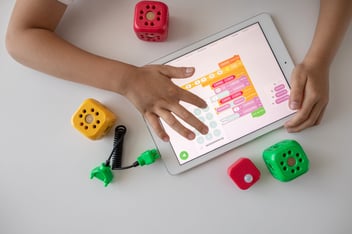Multimodal learning engages learners, makes learning more effective, and also improves accessibility. Any educator would be glad to offer these advantages to their students. But, incorporating multimodal learning into courseware or making use of it in the classroom isn’t always straightforward. There are many possible ways to use multimodal learning, and not all of them guarantee the best outcomes.
To help instructional designers and other education professionals, we’ve put together 5 tips to support multimodal learning when designing courses, curriculum materials, or planning for its use in the classroom:
1. Train and Prepare Ahead of Time
Some multimodal learning approaches are technology-intensive. As a result, both administrators and teachers need to ensure that staff and students are prepared to engage with the technology. For example, teachers may need training to use educational apps and programs like Listenwise. Surveys show that up to 90% of teachers believe that training is essential for helping them “deliver effective virtual learning experiences,” which naturally include multimodal learning experiences. With training, teachers can make the best use of all of the resources available.
Similarly, students may need instruction and guidance before they’ll be able to master the use of digital tools including AR and VR resources, online learning platforms, apps, and more. This is especially true during remote learning, as the teacher isn’t physically present to help students.
2. Set Clear Learning Objectives
As with any learning resource, setting clear learning objectives is a key strategy for success. When implementing multimodal learning in courseware, there should be a clear goal for each resource used. For example, if you decide to include an educational video in your lesson, the resource could support goals such as:
- Drawing interest to a topic
- Explaining a theme or topic
- Presenting an opposing opinion
- Inspiring discussion
- Reviewing a topic and then answering a follow-up quiz
- Inspiring an essay or literary response
Many multimodal learning activities and resources including STEM projects and experiments, field trips, podcasts, digital learning apps, and more can also be incorporated successfully into a course or lesson. Simply ensure that you build the lesson around greater learning goals that tie into state standards or course objectives.
3. Consider the Whole Student
Multimodal learning in early years is more likely to encompass the whole student, considering their social and emotional needs as well as academic training. However, when students are older or adults, it can be easy to overlook emotional and social well-being.
When considering a multimodal model, Dr. Anthony G. Picciano argues that “social and emotional development is an important part of anyone’s education. Faculty who have taught advanced graduate courses know that the students, even at this advanced level, frequently need someone with whom to speak whether for understanding a complex concept or providing advice on career and professional opportunities.” This is true for students at all levels, including those in professional development and ongoing education courses. Multimodal resources can be provided to support these needs, including multimedia communication, professional networking support via social media, and more.
4. Let the Content Lead
One of the most important rules for using multimodal learning is letting the content lead. What does that mean? Certain study areas fit certain learning modes better than others. For example, geography lends itself to the use of lots of visual resources such as maps and photos. Yet, studying music obviously necessitates the use of auditory resources. Rather than trying to force a certain media type to fit your lesson, let the content lead.
5. Less Can Be More
Multimodal learning means that you include several modes of learning at once, such as video, audio, and text. Yet, it’s important to keep in mind that you can overwhelm your students with too much information at once. Although many people may claim that they’re able to multitask, the reality is our brains were not made to do this. For this reason, try to limit the stimulants in the multimodal resources, especially the technology-heavy resources, you use.
For instance, if you consider using a website as a resource in your courseware, opt for clean designs without flashing lights, excessive advertisements, and multiple videos. Too much sensory input can be distracting rather than beneficial. Also, while subtitles may be helpful for educational videos, when audio content differs from the text content, it can be too much to keep track of. Try to ensure that students will be able to absorb all of the input without going into overdrive or checking out.
Create Your Multimodal Learning Environment Now
With these tips, you can successfully use multimodal learning in your courseware, bringing many benefits and advantages to your students. How do you approach multimodal learning? Let’s discuss! Get in touch with us on Facebook, LinkedIn, or Twitter. We’d love to hear from you!
Rachel Peachey
Rachel is an education industry writer and former Montessori schoolteacher. Originally from Pennsylvania, Rachel lives in Guatemala with her husband and three children.
- #Classroom
- #Video in Digital Learning
- #Educational Videos
- #Tips for Using Video
- #Video Content Partners
- #Boclips for Publishers
- #Issues in Education
- #Educational Videos by Subject Area
- #News and Announcements
- #Events & Holidays
- #Video and Teaching Tools
- #Teaching Methodologies
- #Education Videos
- #Video and Digital Literacy
- #Short Educational Videos
- #Instructional Design
- #Multimodal Learning
- #Video and Student Safety
- #Accessibility in Education
-3.png?width=390&height=223&name=Untitled%20design%20(2)-3.png)


.png?width=1152&height=660&name=Copy%20of%20Untitled%20Design%20(1).png)



